Aprilia RS660 Test by Adam Child
We’re told the supersport market is dead, and yes, sales show a monumental decline in this class over the last two decades, but these exciting, dedicated track bikes are simply that, race bikes, with high revving engines and radical riding positions that can be hard work for everyday use on the road. But despite its supersport styling, Aprilia’s RS660 wasn’t designed for the track; this is a comfortable and unintimidating road bike with a typically Aprilia sporting edge.
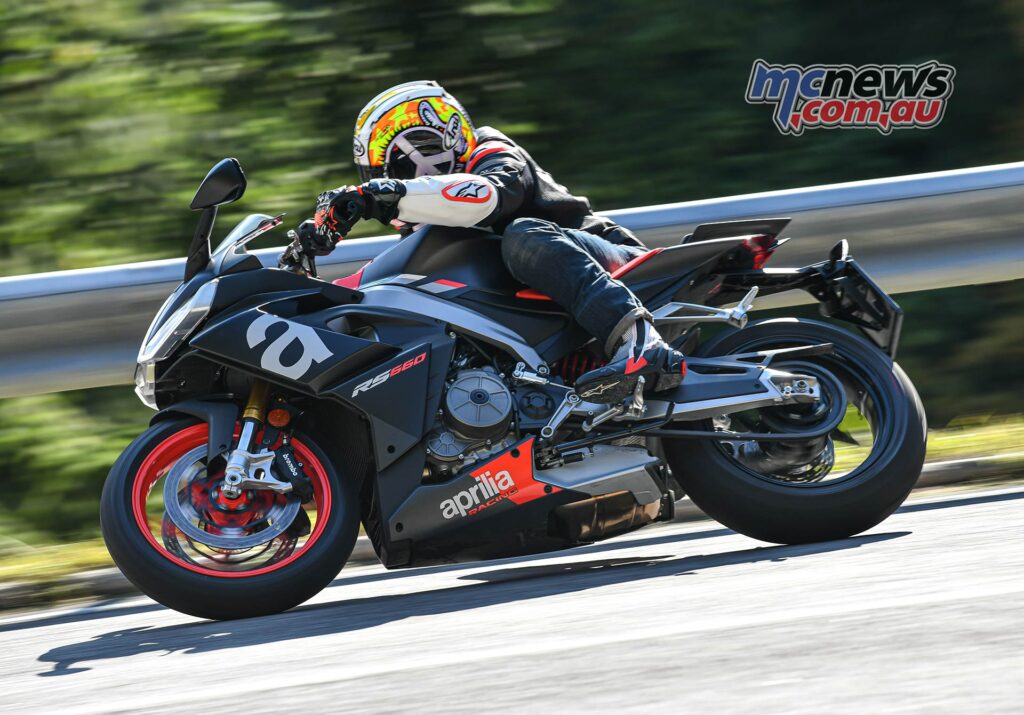
The RS660 is powered by a parallel twin with a 270-degree crank, which is essentially the front half of the RSV4. But although the RS660 is an ‘entry-level’ bike for Aprilia, and is designed for a young and inexperienced audience, it’s neither bland nor dull – the opposite in fact – and sports even more rider aids than Aprilia’s flagship superbike RSV4. Cornering ABS, multiple track and rider modes, traction and wheel control, an up-and-down quick-shifter, even cruise control make for a world class array of electronic aids on a 100 horsepower sub $20,000 bike.
Does it handle?
It has a short wheelbase at just 169 kg dry or 183 kg with fuel it is light, there’s adjustable suspension, a wide 180-section rear hoop, and that purple and red colour scheme is somewhat reminiscent of the legendary two-stroke RS250. If you don’t know what that is ask a grown up.
The seat has some padding, the bars are relatively high and wide, the ergonomics are comfortable and the pegs are relatively low. Not what I was expecting. The parallel twin is a road bike first and foremost, but one that can also be taken to the track.
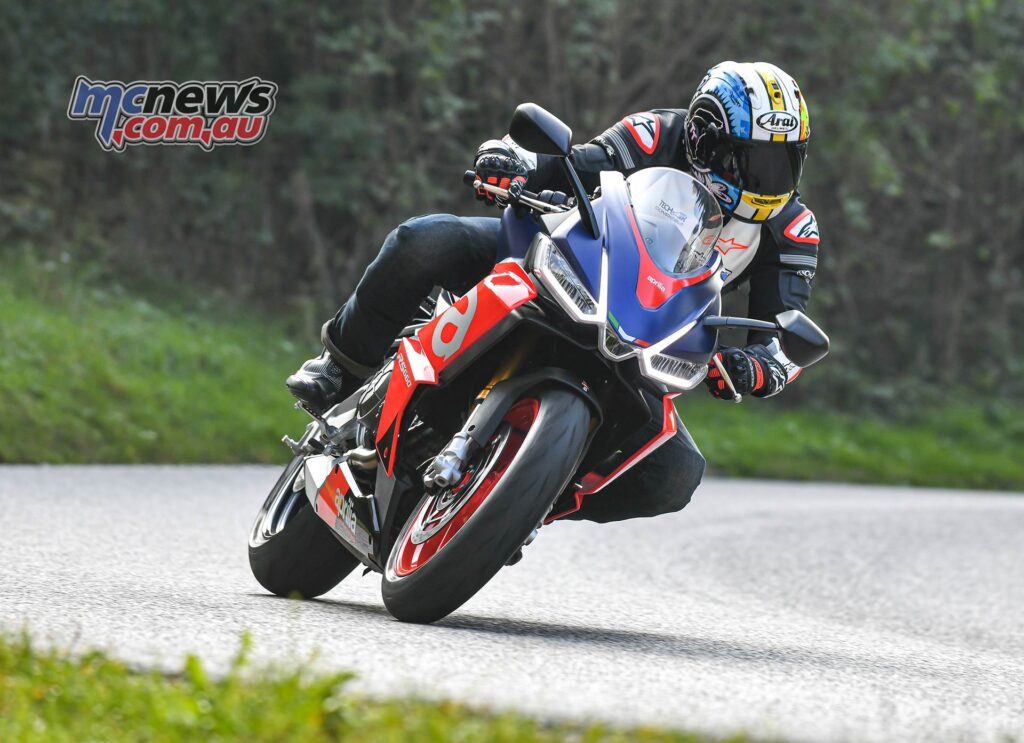
The steering is light, which is exaggerated by the wide bars. It’s fun, yet stable, giving you the option to steer into the corner, or hang off the inside, knee on the deck. It is user friendly and welcoming, you just jump on and ride, safe in the knowledge you have excellent rider aids at hand, should you get in a little too hot.
Kayaba 43 mm forks are fully adjustable and were flawless on the road test. The rear unit is also adjustable (aside from compression), and even at a sharp road pace is hard to fault. Arguably it doesn’t have the plush ‘top-level’ feel of quality Öhlins units or similar and I’m sure you’ll need a little more support on track with race tyres. But, overall, it’s an easy handling road bike. I’m sure a more purpose track version will be coming soon……
Standard radial Brembo stoppers with braided lines and radial master cylinder are more than up for the job, especially when you consider the bike’s lack of weight. When stopping 183 kg from a top speed of around 230 km/h, you don’t need the most expensive race-spec Brembo stoppers. The feel is excellent, even the back brake, and the cornering ABS isn’t intrusive on the road.
Interestingly, you have three levels of ABS. The most intrusive is cornering ABS front and rear, mode two is similar but less intrusive, and mode one is conventional ABS on the front, not cornering ABS and no ABS on the rear, which in experienced hands with the standard slipper clutch allows you back into corners for fun.
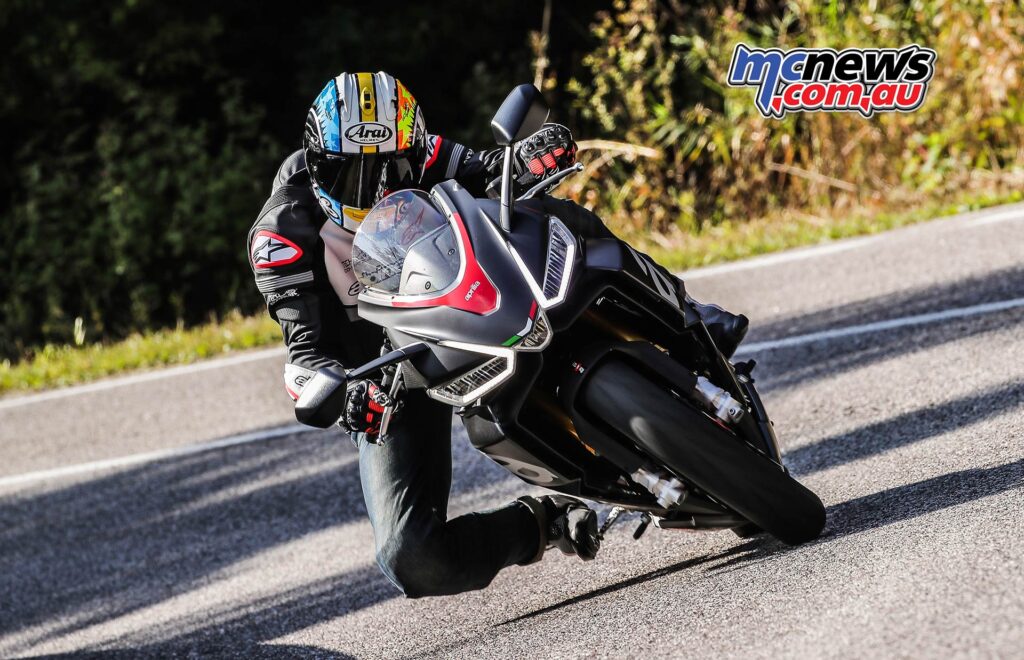
Is it quick?
What Aprilia has done is essentially use their RSV4 as a base, chopping the V4 engine in half to produce a parallel twin. The bore size is the same as the RSV4 1100, but the stroke is up to 63.93 mm, not the 52.3 mm of the V-Four.
The twin-cylinder DOHC engine produces a respectable 100 horsepower at 10,500 rpm and 67 Nm at 8500 rpm, that is more torque than a Yamaha R6 or Honda CBR650R. The little twin will bounce off the rev limiter at 11,500 rpm but with a race kit will rev on for another 1000 rpm. But this isn’t a race engine; 80 per cent of the torque is available from as low as 4000rpm, and 90 per cent of the twist is available from 6250rpm.
You don’t simply magically cut the V4 in half. There’s a new clutch, a new intake system, a new cylinder head, new 48 mm throttle bodies… this is an entirely new engine, albeit one that leans on the experience and knowledge gained from the V4. Aprilia has made the engine run smoother, with a new counter-weighted 270-degree crankshaft. The engine is a structural part of the bike, too, the swing-arm bolts directly to the rear of the crankcases.
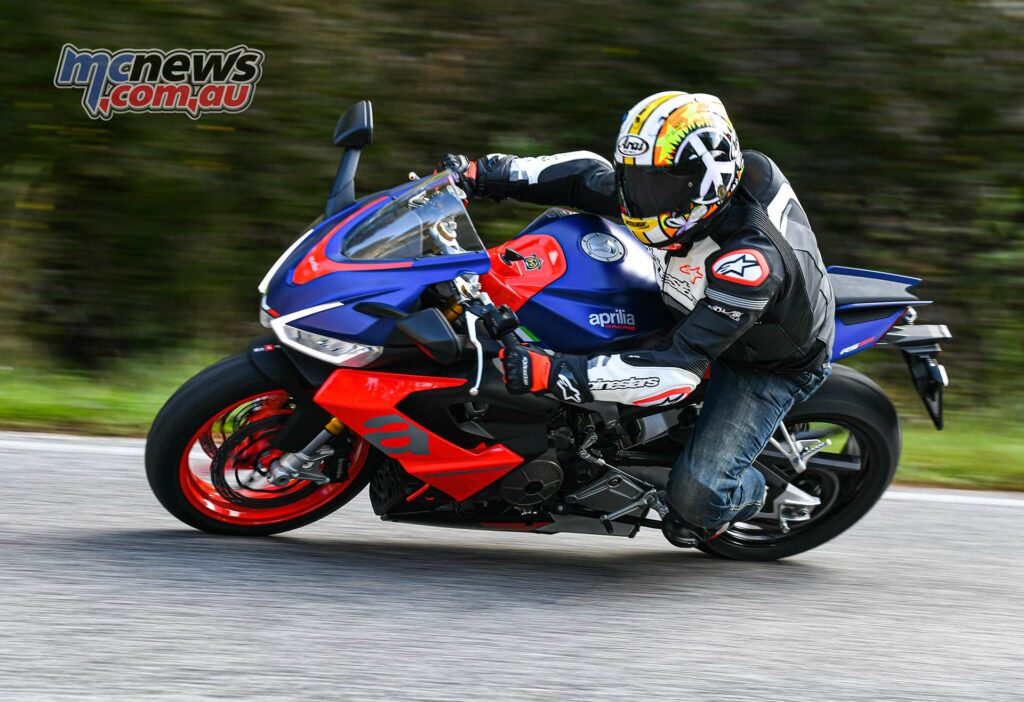
The 270-degree crank gives the RS660 a distinctive exhaust tone, very much like a slow revving RSV4. It doesn’t sound like a Kawasaki Z650 (with its 180-degree crank), the Aprilia is much smoother. The light, one-piece, 6.2 kg exhaust consists of one silencer per cylinder plus a cat’ exhaust/collector box, which then exits on either side of the rear tyre. The two jutting exhausts not only gives the 660 a rare sound but also a distinguishing symmetrical look. A tickle of the ride-by-wire throttle allows the revs to dart up the full colour TFT digital dash. The revs build fluently, quicker than I was expecting, and for a standard exhaust, the system adds a little spirit to the RS660 experience.
There are five riding modes to opt from: three for the road – Commute, Dynamic and Individual – and two for the track – Challenge and Track Attack. Each mode changes the engine character, feeling and the multiple rider aids, including traction and wheelie control, cornering ABS, engine brake assist, while the-up-and-down quick-shifter which comes as standard is the same in all modes. Again, you can change and personalise each mode if you wish. It’s simple and intuitive, the new switchgear makes it easier than ever.
To start I opted for the commute mode, with the fuelling set to three, the kindest setting. The fuelling was perfect. Aprilia has a world-class fuelling team, throttle response is always perfect, which is particularly impressive for a parallel twin. Again, like the premium RSV4 1100, the quick-shifter is perfect too, both up and down.
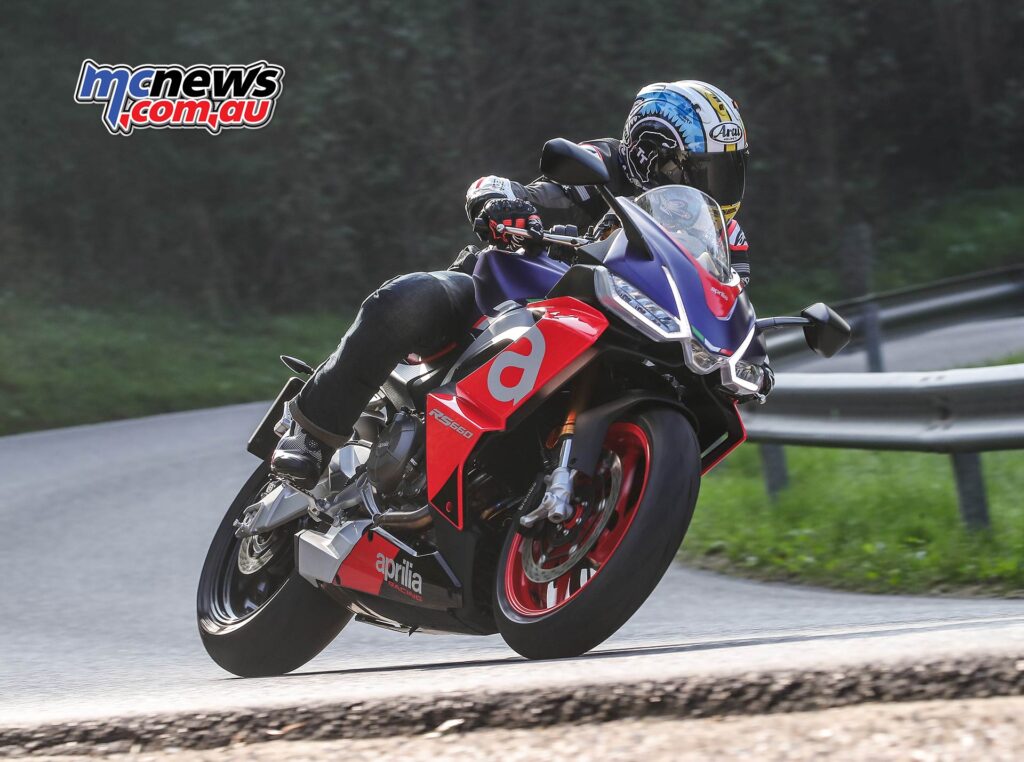
As we headed into the Alps it was time to flick from Commute mode to Dynamic, which automatically changes the engine character and response, and lessens the intrusion of rider aids. The response is a little sharper, especially from a closed to an open throttle. It’s not snatchy, the fuelling is again excellent. Power is relatively linear and you can short-shift on the rapid quick-shifter and still make progress.
There’s a little boost around 7500 rpm, and the modest twin loves to rev to the limiter at 11,500 rpm. It’s so entertaining to thrash, tapping up and down the quick-shifter with the clutch redundant, excellent rider aids and cornering ABS on hand if the road surface should unexpectedly change.
Then, for sheer (and immature) amusement, I switched into the Individual mode, which I’d previously pre-set for no traction control, no anti-wheelie, power on the most aggressive mode, engine braking down to one, and ABS set to one, which means only conventional ABS on the front, not cornering ABS and no ABS on the rear.
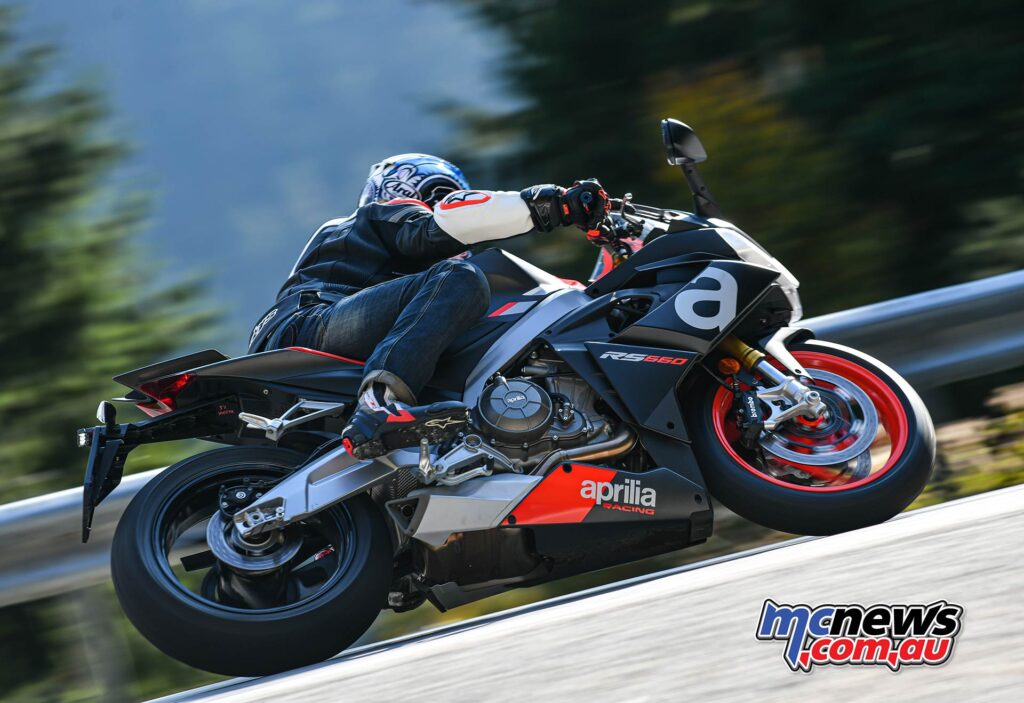
The RS660 will wheelie in the first two gears with some encouragement from the clutch. It’s a great engine to stir, and thankfully, when you look down at the full colour TFT dash, you’re not doubling the speed limit and facing a jail sentence. The RS660 is reasonably quick, I’d estimate top speed is around 230 km/h, but unlike a RSV4 it’s not scary on the road, dare we say even practical.
The new parallel twin is frugal on fuel. Aprilia quote 4.89l-100km, but on a steady ride in the afternoon I managed 4.15l-100km, which gives a possible tank range (15L tank) of over 321km. Four hours in the saddle wouldn’t be heartbreak either, because the ergonomics are roomy for this type of bike, with pegs lower than the RSV4 and the bars that are wide.
The bodywork is also impressive; the screen is almost a double bubble TT style screen, making it straightforward to get tucked in at speed, and at motorway cruising speeds does a half-decent job of wind protection.
120 km/h equates to around 6000 rpm and, while there are a few vibrations felt from the pegs and a little from the bar ends as the speed and revs increase, it’s nothing unpleasant. Aprilia even offers a tail pack and a tank bag as optional extras, and I’d happily take on some serious miles on the RS660 and even use the cruise control.
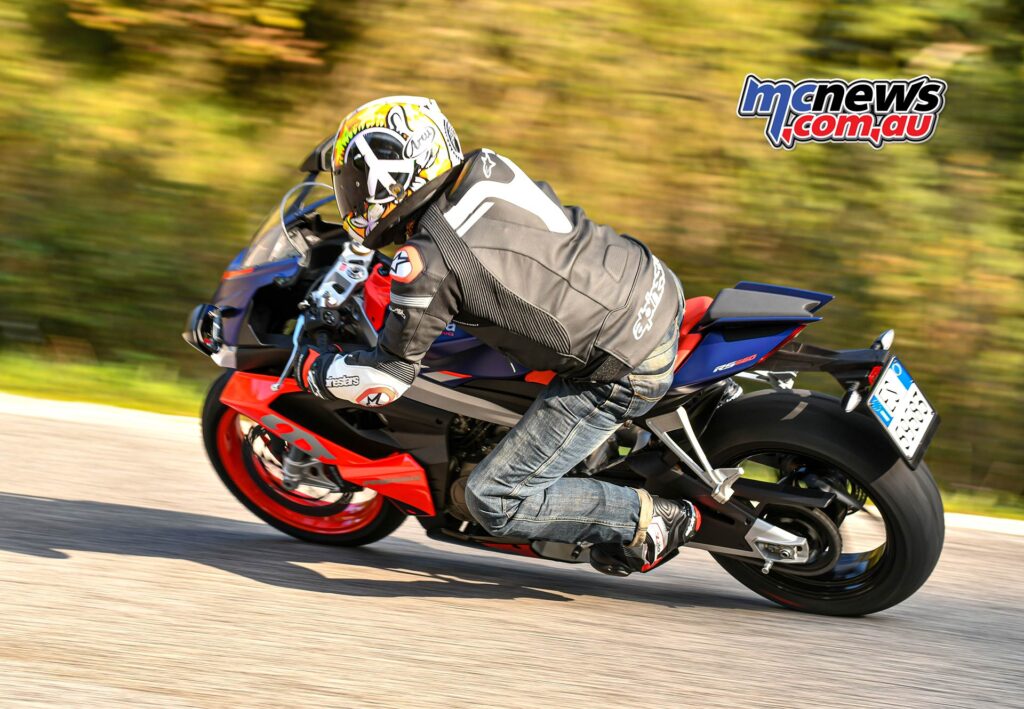
Gadgets to keep the youngsters happy
Rider aids aren’t really needed on a 100 horsepower middleweight already furnished with a first-rate chassis and tyres. But you have to remember the young audience which Aprilia is attracting, and for more experienced riders they can to de-activated even on the move.
At your finger tips are multiple rider modes, eight-stage traction control, wheelie control, engine brake assist plus cornering ABS and conventional ABS. Additionally, you have cruise control and an up-and-down quick-shifter. The modes are straightforward to change on the fly, and you can even de-active the traction and wheelie control.
The array of rider aids is impressive, but I favor the thumb and finger traction control toggle switches on the RSV4 Factory. Furthermore, the RS’s rider aids aren’t displayed on the main menu whilst riding. The rider modes are clear but you can’t, for example, glance down and see how much TC you’re running – that info is within a sub-menu.
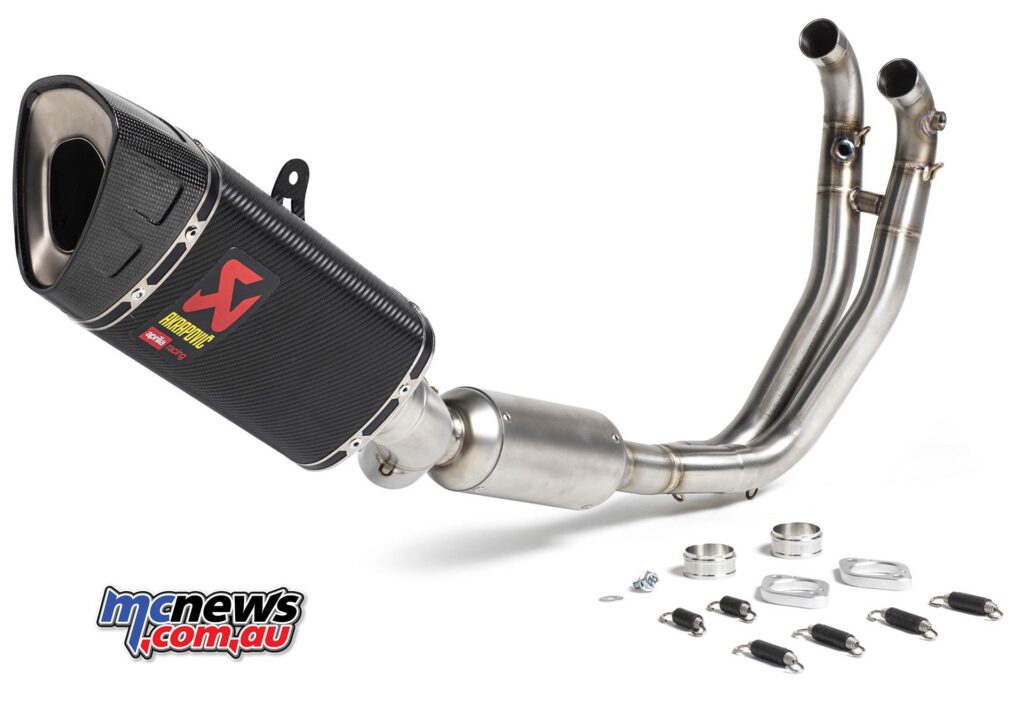
There are the typical accessories from Akrapovic, including a full exhaust. There is also additional software available which means you can flick over to a race shift, and have access to a pit lane limiter. Away from the racetrack, there is a comfortable seat, USB socket, luggage… even a larger fairing and Bluetooth connectivity.
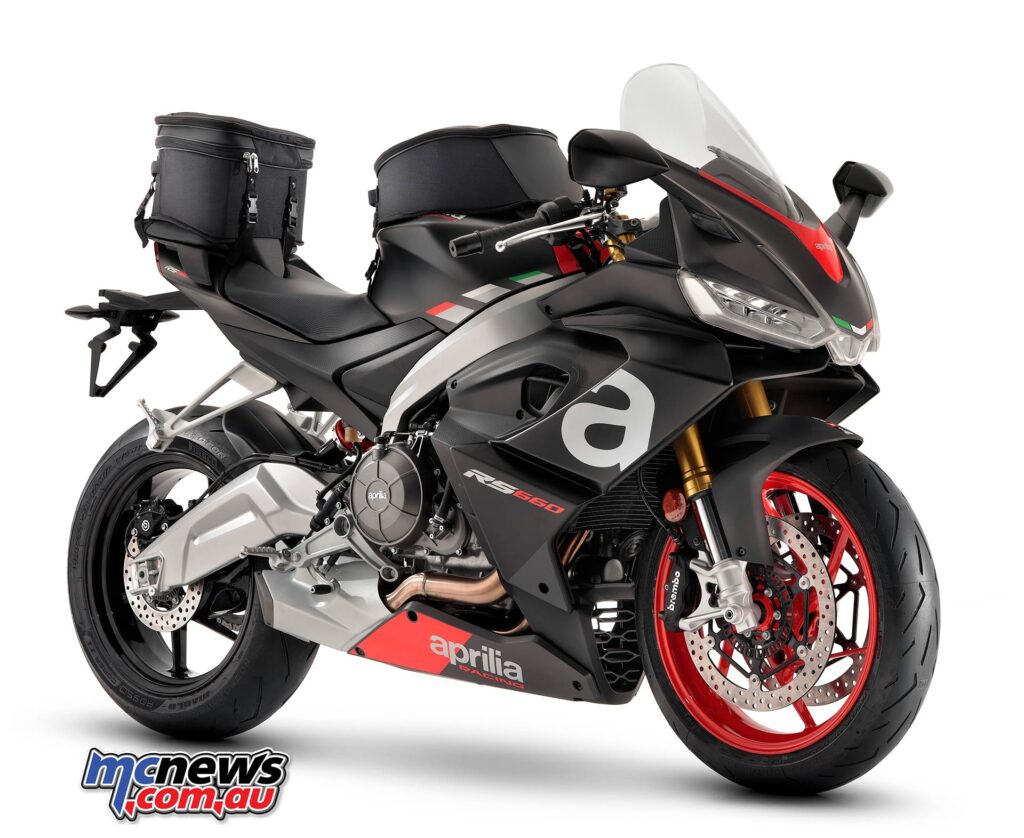
2020 Aprilia RS660 Verdict
I’m impressed with Aprilia’s new RS660. A usable, friendly, road-going sports bike overloaded with rider aids and just about affordable, just. The versatile engine that should not get you into too much difficulty and there is the safety net of top level rider aids.
It sounds great, has character, is eye-catching, and is desirable.
Aprilia has possibly gone a little overboard on the rider aids, and the suspension may need an upgrade for some serious racing/track action – but I’m sure there will be a sportier version in the pipeline soon. I can wait to try it on track. A multitalented, entertaining, attractive bike for the inexperienced and experienced alike – top work Aprilia
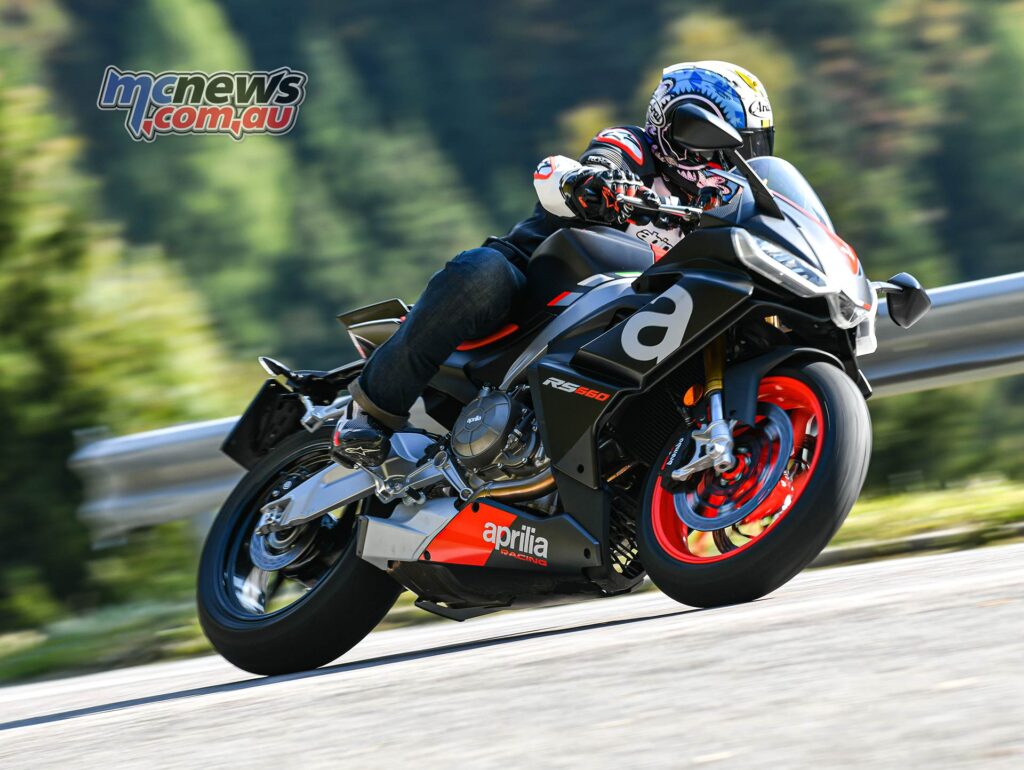
Aprilia RS660 Specifications
| Aprilia RS660 Specifications | |
| Engine | 659 cc four-stroke, parallel-twin, 270-degree |
| Bore x Stroke | 81 x 63.93 mm |
| Compression Ratio | 13.5:1 |
| Claimed Power | 100 hp (73.5 kW) at 10,500 rpm |
| Claimed Torque | 67 Nm at 8500 rpm |
| Induction | 2 x 48 mm EFI throttle bodies. RbW |
| Gears | Six, AQS Aprilia Quick Shift |
| Clutch | Wet, multi-plate, slipper |
| Frame | Aluminium dual beam chassis with removable seat support subframe |
| Forks | Kayaba 41-mm forks, aluminium radial calliper mounting bracket. Adjustable spring preload and rebound damping. 120 mm wheel travel. |
| Shock | Aluminium asymmetric swingarm. Adjustable monoshock in spring reload, rebound. 130 mm wheel travel. |
| Tyres | 120/70-17 (F), 180/55-17 (R) |
| Front Brakes | Front ABS: double disc, diameter 320 mm, Brembo radial callipers with four Ø32-mm opposing pistons. Radial pump and metal braided brake hose. |
| Rear Brake | Ø220-mm disc; Brembo calliper with two Ø34-mm separate pistons. Pump with integrated tank and metal braided hose |
| Electronics | Six-axis inertial platform, APRC package containing ATC (traction control), AWC (wheelie control), AEB (engine braking), AEM (engine maps) and ACC (cruise control). 5 Riding modes (Road and Track, 3 fixed and 2 customisable) |
| Instrumentation | Full-colour TFT |
| Dry Weight | 169 kg (TBC) |
| Kerb Weight | 183 kg (TBC) |
| Seat Height | 815 mm (TBC) |
| Wheelbase | 1370 mm |
| Rake / Trail | 24.1 degrees / 104.6 mm |
| Fuel Capacity | 15 litres |
| Service Intervals | / |
| Warranty | / |
| Available | March-April 2021 |
| Price | Approx $18,500 to $19,000 Ride Away TBC |

Aprilia RS660 Images




























